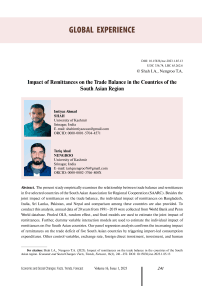Impact of remittances on the trade balance in the countries of the South Asian region
Автор: Shah Imtiyaz Ahmad, Nengroo Tariq Ahad
Журнал: Economic and Social Changes: Facts, Trends, Forecast @volnc-esc-en
Рубрика: Global experience
Статья в выпуске: 1 т.16, 2023 года.
Бесплатный доступ
The present study empirically examines the relationship between trade balance and remittances in five selected countries of the South Asian Association for Regional Cooperation (SAARC). Besides the joint impact of remittances on the trade balance, the individual impact of remittances on Bangladesh, India, Sri Lanka, Pakistan, and Nepal and comparison among these countries are also provided. To conduct this analysis, annual data of 20 years from 1991-2019 were collected from World Bank and Penn World database. Pooled OLS, random effect, and fixed models are used to estimate the joint impact of remittances. Further, dummy variable interaction models are used to estimate the individual impact of remittances on five South Asian countries. Our panel regression analysis confirms the increasing impact of remittances on the trade deficit of five South Asian countries by triggering import-led consumption expenditures. Other control variables, exchange rate, foreign direct investment, investment, and human capital have a significantly negative impact on the trade balance. On the other hand, rent has a significant positive impact on the trade balance of SAARC countries. Dummy variable interaction model confirms the negative impact of remittances on India, Nepal, and Pakistan, while remittances have an insignificant impact on Bangladesh and Sri Lanka. The paper provides various policy impactions for SAARC region.
Remittances, trade balance, south asia, panel data
Короткий адрес: https://sciup.org/147240256
IDR: 147240256 | DOI: 10.15838/esc.2023.1.85.13
Список литературы Impact of remittances on the trade balance in the countries of the South Asian region
- Akoto L. (2019). Empirical analysis of the determinants of trade balance in post-liberalization Ghana. Foreign Trade Review, 54(3), 177–205.
- Alferi A., Havinga I., Hvidsten V. (2005). Definition of Remittances and Relevant BPM5 Flows. New York: Statistics Division, United Nations.
- Barro R., Sala-i-Martin X. (2004). Economic Growth. 2nd edition. Cambridge, MA: MIT Press.
- Bhattacharya S.K., Das G.G. (2014). Can South–South Trade Agreements reduce development deficits? An exploration of SAARC during 1995–2008. Journal of South Asian Development, 9(3), 253–285.
- Bjorvatn K., Farzanegan M.R. (2013). Demographic transition in resource rich countries: A blessing or a curse? World Development, 45, 337–351.
- Bouhga-Hagbe J. (2004). A theory of workers’ remittances with an application to Morocco. IMF Working Paper, 04, 194. Washington D.C.: International Monetary Fund.
- Falk M. (2008). Determinants of the Trade Balance in Industrialized Countries. FIW Research Report 13. Vienna.
- Farzanegan M.R., Sherif M.H. (2016). How does the flow of remittances affect the trade balance of the Middle East and North Africa? SSRN Scholarly Paper. Rochester, New York: Social Science Research Network.
- Farzanegan M.R., Sherif M.H. (2020). How does the flow of remittances affect the trade balance of the Middle East and North Africa? Journal of Economic Policy Reform, 23(2), 248–266.
- Hasan G.M., Shakur S. (2017). Nonlinear effects of remittances on per capita GDP growth in Bangladesh. Economies, 5(3), 1–11.
- Hasan M. (2003). Export performance of South Asia after trade liberalization in the early 1990s. The Chittagong University Journal of Business Administration, 18, 107–120.
- Khan M.A., Faheem U.R., Hussain F., Razzaq A. (2021). Study on determinants of trade deficit in selected SAARC countries: The role of infrastructure. Indian Journal of Economics and Development, 9, 13.
- Lall S. (2000). The technological structure and performance of developing country manufactured exports, 1985–1998. Oxford Development Studies, 28(3), 337–369.
- Lartey E.K.K. (2018). The effect of remittances on the current account in developing and emerging economies. Policy Research Working Paper, 8498. Washington, D.C.: World Bank.
- Nguyen P.H. (2017). The impact of remittance on trade balance: The case of Malaysia. Journal of Economics and Public Finance, 3, 531.
- Okodua H., Olayiwola W. (2013). Migrant workers' remittances and external trade balance in Sub-Sahara African countries. International Journal of Economics and Finance, 5. DOI: 10.5539/ijef.v5n3p134.
- Pfaffermayr M. (1996). Foreign outward direct investment and exports in Austrian manufacturing: substitutes or complements? Weltwirtschaftliches Archive, 132(2), 501–522.
- Ramirez M., Sharma H. (2008). Remittances and growth in Latin America: A panel unit root and panel cointegration analysis. Estudios Economicos de Desarrollo Internacional, Euro-American Association of Economic Development, 9(1), 5–36.
- Rifa F., Thahara A.F., Fathima R., Kalideen S. (2021). The relationship between exchange rate and trade balance: Empirical evidence from Sri Lanka. Journal of Asian Finance Economics and Business, 37-0041.
- Sutradhar S. (2020). The impact of remittances on economic growth in Bangladesh, India, Pakistan, and Sri Lanka. International Journal of Economic Policy Studies, 14(3).
- Topxhiu R.M., Krasniqi F.X. (2017). The relevance of remittances in fostering economic growth in The West Balkan countries. Ekonomika, 96(2), 28–42.
- Tung L.T. (2018). Impact of remittance inflows on trade balance in developing countries. Economics and Sociology, 11(4), 80–95.
- Wood A., Mayer J. (2001). South Asia’s export structure in a comparative perspective. Oxford Development Studies, 29, 5–29. DOI: 10.2139/ssrn.189810


